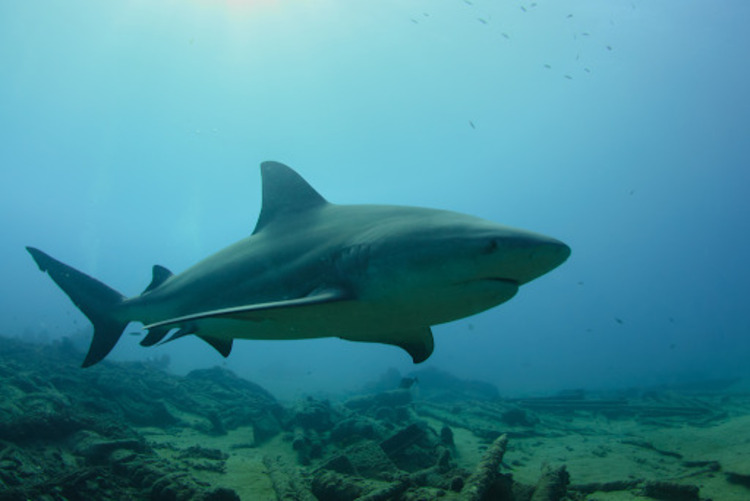- The Mekong Giant Catfish: Thailand River Titan
- The Alligator Gar: A Prehistoric Survivor
- The Arapaima: Colossal Fish Residing in the Lakes of South America
- The Giant Freshwater Stingray: A Mysterious Presence in Thailand’s Waters
- The Largetooth / Freshwater Sawfish
- The Chinese Paddlefish: A Giant Now Extinct
- The Incredible Giant Barbъ
- The Majestic Sturgeon: A River Giant
- White Sturgeon:
- Beluga Sturgeon:
- The Mighty Nile Perch
- The Elusive Siberian Taimen
- The Fierce Bull Sharks
- The Intriguing Connection between Saltwater and Freshwater Giants
- The Symbiotic Relationship of Freshwater and Marine Giants
- Why Aquatic Animals Outsize Those on Land
- FAQs
- Q: What are some of the largest freshwater fish in the world?
- Q: Are all large freshwater fish threatened or endangered?
- Q: Can I release a large freshwater fish after catching it?
- Q: How big can the largest freshwater fish get?
- Q: Are there any regulations on catching large freshwater fish?
Have you ever wondered about the incredible diversity of life that inhabits our planet’s freshwater systems? From the winding rivers to the tranquil lakes, these ecosystems harbor some truly astonishing creatures! Among these, some of the most awe-inspiring are the gigantic fish that call these waters home. This article is your ticket to embark on an adventure exploring 12 of the most remarkable species, from the majestic Sturgeon to the fearsome Alligator Gar.

These creatures are not just big fish in a small pond. They are true aquatic giants, and their fascinating stories are waiting to be told. So, why don’t we jump right into the deep end and unveil the mysteries of these marvelous behemoths? But be warned, once you’ve dived into the world of these freshwater giants, there’s no turning back! So, are you ready to go on this thrilling journey?
The Mekong Giant Catfish: Thailand River Titan
Let’s now shift our attention to the Mekong Giant Catfish, another behemoth in the world of freshwater fish. This fish is characterized by its scale-less, silvery-grey body and wide, downturned mouth – a design perfected for bottom-dwelling.

The Mekong Giant Catfish, as its name suggests, primarily inhabits the Mekong River. This river courses through several countries, including China, Myanmar, Laos, Thailand, Cambodia, and Vietnam, providing a vast playground for this river titan.
Competing closely with the Beluga, the Mekong Giant Catfish can grow to lengths of up to 10 feet and weigh about 650 pounds. It’s an animal embodying the phrase ‘giant of the deep.’
For those looking to add the Mekong Giant Catfish to their list of sighted types, Thailand is the place to be. The angling parks in Cha Am and Phuket are renowned for their populations of this colossal fish.
The Alligator Gar: A Prehistoric Survivor

The alligator gar is a sight to behold. Truly a relic of the past, this kind has a distinct and, shall we say, “fierce” look with a snout resembling that of an alligator (hence the name). Covered by a coat of hard, diamond-shaped scales, it’s a formidable presence in the waterways it calls home.
The alligator gar is primarily found in the United States’ southern parts, making it home in rivers, lakes, and even brackish waters. Its range extends from Florida to Texas, and north along the Mississippi River and its tributaries.
How large can this behemoth get, you ask? The alligator gar can reach lengths of up to 3.05 meters (10 feet) and weigh as much as 159kg (350 pounds). Now that’s a lot of fish!
For those interested in seeing these creatures in their natural habitat, some of the best spots are in the southern United States, particularly in Texas and Louisiana where alligator gar is plentiful.
The Arapaima: Colossal Fish Residing in the Lakes of South America

Now, let’s travel to the lakes of South America and meet the Arapaima. This fish is a giant — one of the largest freshwater kinds in the world. It has a streamlined body, a tapered head, and a wide mouth that makes it a formidable predator in its habitat.
The Arapaima is endemic to the Amazon Basin, so you’ll mostly find them in Brazil, Peru, Ecuador, and Bolivia. They prefer slow-moving, oxygen-poor waters, and they’ve adapted to their environment by developing the ability to breathe air.
Read more: Anglers Guide to Massachusetts Freshwater Fish Species
An Arapaima can grow up to 3 meters (almost 10 feet) in length and can weigh up to 200 kilograms (440 pounds). That’s a big fish, no matter how you slice it!
If you’re an adventurous angler, the Amazon Basin is your best bet for catching a glimpse of this gigantic fish. Just remember: these are endangered creatures, so catch-and-release is the name of the game.
The Giant Freshwater Stingray: A Mysterious Presence in Thailand’s Waters

The Giant Freshwater Stingray is an intriguing inhabitant of freshwaters in Southeast Asia. With a flat body and a long, whip-like tail, this kind is truly unique. Its body can be as wide as a car, and its tail can reach lengths of over 16 feet!
Found in rivers and estuaries across Southeast Asia, these fish have been spotted in countries like Thailand, Cambodia, and Malaysia. Interestingly, their populations are often concentrated in areas near Buddhist temples, where they are protected by religious beliefs.
These stingrays can grow impressively large, reaching up to 800 pounds and 14 feet in length. Their size alone makes them a fascinating sight for those lucky enough to encounter them.
As for angling, the best spots are in Thailand, particularly in the Maeklong and Chao Phraya rivers. However, remember, that this activity should be done responsibly due to the species’ vulnerable status.
The Largetooth / Freshwater Sawfish

The Largetooth Sawfish, or the Freshwater Sawfish, is another massive kind that makes its home in the world’s freshwaters. With a long, saw-like snout lined with sharp teeth, this fish is as intimidating as it is fascinating.
This kind was once found throughout the world’s tropical regions, from the Atlantic to the Pacific Oceans. Today, however, they are mostly found in Northern Australia and Papua New Guinea.
The Largetooth Sawfish is one of the world’s largest fish, capable of reaching lengths of up to 23 feet and weights of over 1,300 pounds!
For those interested in angling, the best spots to catch a glimpse of these magnificent creatures are in Australia, particularly in the rivers of the Northern Territory. Again, it’s important to note that this kind is critically endangered, so any interaction should be done with utmost respect for their conservation.
The Chinese Paddlefish: A Giant Now Extinct

The Chinese Paddlefish (Psephurus gladius) was an astonishing freshwater fish kind, now sadly extinct. Known for its distinctively long, sword-like snout and large size, it was a sight to behold.
This fascinating kind was native to China, where it resided primarily in the Yangtze River and its tributaries. The paddlefish was a migratory species, moving upstream for spawning in the river’s fast-flowing waters.
This species was renowned for its enormous length. It could grow up to 7 meters (23 feet) long, truly making it a giant among freshwater fish.
Unfortunately, because of its disappearance, there are no more places to catch this magnificent creature. It serves as a stark reminder of the importance of conservation.
The Incredible Giant Barbъ

The Giant Barb (Catlocarpio siamensis) is another impressive freshwater species. This fish is native to Southeast Asia and is recognized as the national fish of Cambodia.
The Giant Barb can be found in the Mekong and Chao Phraya River systems in Cambodia, Laos, Vietnam, and Thailand. These river systems provide the perfect habitat for this species, with ample food and space for growth.
The Giant Barb lives up to its name. This species can grow up to 3 meters (9.8 feet) in length and weigh up to 300 kilograms (660 pounds), making it one of the largest species of cyprinid in the world.
As for the best angling spots, the Tonle Sap River and Lake in Cambodia are renowned for their Giant Barb populations. However, due to the declining population of this species, angling is heavily regulated to ensure its survival. So, while visiting these spots could give you a chance to see this incredible creature, catching one is another matter entirely.
The Majestic Sturgeon: A River Giant

White Sturgeon:
The white sturgeon is an impressive species that can be identified by its elongated body and flattened snout. This species is unique in the sense that it lacks bones and instead has cartilaginous structures. With skin that is a grey-white shade, they truly are a sight to behold.
These remarkable creatures are mainly found in North America, particularly in the rivers and coasts of Alaska to Central California. They are anadromous, meaning they migrate from the sea to freshwater to spawn.
The white sturgeon is among the largest freshwater species, with the ability to reach lengths of up to 20 feet and weights of more than 1,500 pounds.
As an amateur fisherman, if you’re looking to see one of these river giants, some of the best spots include the Columbia River in Oregon and the Fraser River in British Columbia. These areas are renowned for their high sturgeon populations and scenic surroundings.
Beluga Sturgeon:
Beluga sturgeon is another species that commands attention. Characterized by their diamond-shaped scales and elongated, spindle-like body, they are a sight to behold. Their skin varies in color from dark grey to black.
Beluga sturgeon are native to the Caspian and Black Sea basins but have also been found in the Adriatic Sea. These habitats provide the right conditions for them to thrive.
The Beluga sturgeon holds the title of the largest freshwater species in the world. They can grow up to a staggering 23 feet in length and can weigh as much as 3,300 pounds.
If you are interested in seeing a Beluga sturgeon, the Volga River deltas are considered one of the best spots. However, remember that these fish are critically endangered, and any angling activities should be undertaken responsibly.
The Mighty Nile Perch

Lates niloticus, or the Nile perch, is a fascinating freshwater fish. These creatures are renowned for their large size, often exceeding 100 kilograms. They are characterized by a silver-blue body and a mouth equipped with sharp teeth.
Nile perch inhabit various African rivers and lakes, with Lake Victoria being one of their most notable habitats. The introduction of this species into Lake Victoria in the 1950s has significantly impacted the local ecosystem.
The size of these fish is truly impressive, with some specimens known to reach up to 2 meters in length. Anglers in search of a significant catch should consider visiting Lake Nasser in Egypt or Lake Victoria on the borders of Uganda, Kenya, and Tanzania.
The Elusive Siberian Taimen

The Siberian Taimen, known scientifically as Hucho taimen, is another sizeable freshwater fish. It has a long, streamlined body covered with small scales and a large mouth with sharp teeth, suitable for its diet, which consists mainly of smaller fish.
Their habitats stretch across Northern Asia, from the Yenisei River system in Russia through Mongolia and down to the northernmost parts of China.
The Siberian Taimen can grow to extraordinary sizes, with some recorded to be over 2 meters long. For those looking to observe or catch these magnificent creatures, the rivers of Mongolia, such as the Selenge and Eg rivers, are recommended.
Read more: Freshwater Fishing in Louisiana: Fish Species and Catching Tips
The Fierce Bull Sharks
Bull sharks, or Carcharhinus leucas, are unique among shark species as they can thrive in both salt and freshwater environments. They have a stout body, a broad, flat snout, and an aggressive demeanor.
These sharks are found worldwide and are known to venture far up freshwater rivers. In the U.S., they have been spotted in the Mississippi River, and Australia, they regularly appear in the Brisbane River.
Bull sharks can grow up to 3.5 meters long, making them one of the larger shark species. Those interested in encountering these formidable creatures should consider visiting the waters around Florida, where they are commonly found, or the Zambezi River in Africa, known locally as the ‘River of the Bull Sharks’.
The Intriguing Connection between Saltwater and Freshwater Giants
We often marvel at the sheer scale of life in our oceans. The blue whale, the world’s largest animal, can reach lengths of up to 100 feet. But did you know that our freshwater bodies, too, are home to some truly colossal creatures? Surpassing their land-based counterparts, these aquatic giants offer a fascinating glimpse into the diverse world of underwater life.
The Symbiotic Relationship of Freshwater and Marine Giants
Let’s take a journey into the deep, murky waters of our planet’s freshwater bodies. Here, we encounter the likes of the Beluga sturgeon and the Mekong giant catfish. These behemoths reach truly mind-boggling sizes. The sturgeon, in particular, is known to grow up to 20 feet long. That’s about the length of a small school bus!
But what’s more intriguing is how closely their lives are intertwined with that of their marine counterparts. Many freshwater giants start their lives in the salty waters of the sea, only to migrate to freshwater to grow and mature. This unique life cycle creates a fascinating dynamic between these two seemingly separate worlds.
Why Aquatic Animals Outsize Those on Land
The aquatic world is a realm of giants. But why do aquatic animals grow larger than those on land? The answer lies in the unique characteristics of their watery home.
Water, as a medium, offers buoyancy that counteracts the force of gravity. This allows aquatic animals to grow to sizes that would be impossible on land. Additionally, water’s capacity to carry nutrients far exceeds that of air, providing ample sustenance for growth. Lastly, the vastness of our oceans and freshwater bodies offers a larger living space than land, accommodating larger bodies.
So the next time you find yourself marveling at the size of a towering skyscraper or a massive mountain, remember the real giants living beneath the surface of our waters, in the intricate world of freshwater and marine life.
FAQs
Q: What are some of the largest freshwater fish in the world?
A: Some of the largest freshwater species in the world are the sturgeon, alligator gar, and arapaima.
Q: Are all large freshwater fish threatened or endangered?
A: Although not all, many of the large freshwater fish species are threatened or endangered due to overfishing and habitat destruction.
Q: Can I release a large freshwater fish after catching it?
A: It is advisable to release large freshwater fish after catching them, especially if they are endangered species, to promote conservation efforts.
Q: How big can the largest freshwater fish get?
A: The largest freshwater species can grow up to 12 feet in length and weigh over 600 pounds.
Q: Are there any regulations on catching large freshwater fish?
A: Many regions have regulations for catching large freshwater fish, and it is important to check and adhere to these regulations to protect the species and their habitats.




